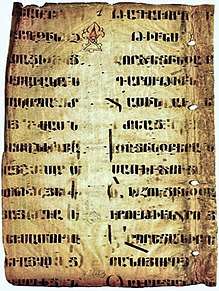Graeco-Armenian
Graeco-Armenian (or Helleno-Armenian) is the hypothetical common ancestor of Greek and Armenian that postdates Proto-Indo-European. Its status is somewhat similar to that of the Italo-Celtic grouping: each is widely considered plausible without being accepted as established communis opinio. The hypothetical Proto-Graeco-Armenian stage would need to date to the 3rd millennium BC and would be only barely different from either late Proto-Indo-European or Graeco-Armeno-Aryan.
| Hypothetical Indo-European phylogenetic clades |
|---|
| Balkan |
| Other |
History
The Graeco-Armenian hypothesis originated in 1924 with Holger Pedersen, who noted that agreements between Armenian and Greek lexical cognates are more common than between Armenian and any other Indo-European language.[1]
During the mid-to-late 1920s, Antoine Meillet further investigated morphological and phonological agreements and postulated that the parent languages of Greek and Armenian were dialects in immediate geographical proximity to their parent language, Proto-Indo-European.[2] Meillet's hypothesis became popular in the wake of his Esquisse d'une grammaire comparée de l'arménien classique.[3]
G. R. Solta does not go as far as postulating a Proto-Graeco-Armenian stage but concludes that the lexicon and the morphology clearly make Greek the language that is the most closely related to Armenian.[4]
Eric Hamp supports the Graeco-Armenian thesis and even anticipates a time that "we should speak of Helleno-Armenian" (the postulate of a Graeco-Armenian proto-language).[5] James Clackson is more reserved, considers the evidence of a Graeco-Armenian subgroup to be inconclusive and believes Armenian to be in a larger Graeco-Armeno-Aryan family.[6]
Evaluation of the hypothesis is tied up with the analysis of Indo-European languages, such as Phrygian and languages within the Anatolian subgroup (such as Hittite), many of which are poorly attested, but which were geographically located between the Greek and Armenian-speaking areas, and which would therefore be expected to have traits intermediate between the two. While Greek is attested from very early times, allowing a secure reconstruction of a Proto-Greek language dating to about the 3rd millennium BC,[7] the history of Armenian is opaque where its earliest testimony is the 5th-century Bible translation of Mesrob Mashtots. Armenian has many loanwords showing traces of long language contact with Greek and Indo-Iranian languages; in particular, it is a satem language. Also, although Armenian and Attic (Ancient) Greek share a voiceless aspirate series, they originate from different PIE series (in Armenian from voiceless consonants and in Greek from the voiced aspirates).[8]
In a 2005 publication, a group of linguists and statisticians, comprising Luay Nakhleh, Tandy Warnow, Donald Ringe and Steven N. Evans, compared quantitative phylogenetic linguistic methods and found that a Graeco-Armenian subgroup was supported by that five procedures – maximum parsimony, weighted versus unweighted maximum compatibility, neighbor-joining, and the widely-criticized binary lexical coding technique (devised by Russell Gray and Quentin D. Atkinson).[9]
An interrelated problem is whether there is a "Balkan Indo-European" subgroup of Indo-European, which would consist not only of Greek and Armenian but also Albanian and possibly some dead languages, such as Ancient Macedonian and Phrygian. This has been argued for in research by scholars such as G. Neumann, G. Klingenschmitt, J. Matzinger, J. H. Holst. The Balkan subgroup, in turn, is supported by the lexico-statistical method of Hans J. Holm.[10]
See also
References
Citations
- Pedersen 1924.
- Meillet 1925, pp. 1–6; Meillet 1927, pp. 129–135.
- Meillet 1903.
- Solta 1960.
- Hamp 1976, p. 91.
- Clackson 1995, p. 202.
- Georgiev 1981, p. 192.
- Greppin 1996, p. 804.
- Gray & Atkinson 2003, pp. 437–438; Nakhleh et al. 2005, pp. 171–192.
- Holm 2008, pp. 628–636.
Sources
- Clackson, James (1995). The Linguistic Relationship Between Armenian and Greek. Oxford: Wiley-Blackwell. ISBN 9780631191971.CS1 maint: ref=harv (link)
- Georgiev, Vladimir Ivanov (1981). Introduction to the History of the Indo-European Languages. Sofia: Bulgarian Academy of Sciences.CS1 maint: ref=harv (link)
- Gray, Russell D.; Atkinson, Quentin D. (2003). "Language-tree Divergence Times Support the Anatolian Theory of Indo-European Origin". Nature. 426 (6965): 435–439. Bibcode:2003Natur.426..435G. doi:10.1038/nature02029. PMID 14647380.CS1 maint: ref=harv (link)
- Greppin, John A. C. (1996). "[Review] Reviewed Work: The Linguistic Relationship between Armenian and Greek by James Clackson". Language. 72 (4): 804–807. doi:10.2307/416105. hdl:10068/441113. JSTOR 416105.CS1 maint: ref=harv (link)
- Hamp, Eric (1976). "*gweiH- "live"". In Davies, Anna Morpurgo; Meid, Wolfgang (eds.). Studies in Greek, Italic and Indo-European Linguistics offered to Leonhard R. Palmer. Innsbruck: University of Innsbruck. pp. 87–91.CS1 maint: ref=harv (link)
- Holm, Hans J. (2008). "The Distribution of Data in Word Lists and its Impact on the Subgrouping of Languages". In Preisach, Christine; Burkhardt, Hans; Schmidt-Thieme, Lars; Decker, Reinhold (eds.). Data Analysis, Machine Learning, and Applications. Proceedings of the 31st Annual Conference of the Gesellschaft für Klassifikation e.V., Albert-Ludwigs-Universität Freiburg, March 7–9, 2007. Berlin-Heidelberg: Springer-Verlag. pp. 628–636. ISBN 9783540782469.CS1 maint: ref=harv (link)
- Holst, Jan Henrik (2009). Armenische Studien (in German). Wiesbaden: Harrassowitz Verlag. ISBN 9783447061179.CS1 maint: ref=harv (link)
- Meillet, Antoine (1925). "Remarques sur l'étymologie de quelques mots grecs". Bulletin de la Société de Linguistique de Paris (in French). 26: 1–6.CS1 maint: ref=harv (link)
- Meillet, Antoine (1927). "De la prothèse vocalique en grec et en arménien". Bulletin de la Société de Linguistique de Paris (in French). 27: 129–135.CS1 maint: ref=harv (link)
- Meillet, Antoine (1903). Esquisse d'une grammaire comparée de l'arménien classique (in French). Vienna: Imprimerie des PP. Mékhitharistes.CS1 maint: ref=harv (link)
- Nakhleh, Luay; Warnow, Tandy; Ringe, Don; Evans, Steven N. (2005). "A Comparison of Phylogenetic Reconstruction Methods on an Indo-European Dataset" (PDF). Transactions of the Philological Society. 3 (2): 171–192. doi:10.1111/j.1467-968X.2005.00149.x.CS1 maint: ref=harv (link)
- Pedersen, Holger (1924). "Armenier Sprache". In Ebert, Max (ed.). Reallexikon der Vorgeschichte (in German). 1. Berlin: Walter de Gruyter. pp. 219–226.CS1 maint: ref=harv (link)
- Schmitt, R. (1972). "Die Erforschung des Klassisch-Armenischen seit Meillet (1936)". Kratylos (in German). 17: 1–68.CS1 maint: ref=harv (link)
- Solta, G. R. (1960). Die Stellung des Armenischen im Kreise der Indogermanischen Sprachen (in German). Vienna: Mechitharisten-Buchdruck.CS1 maint: ref=harv (link)
